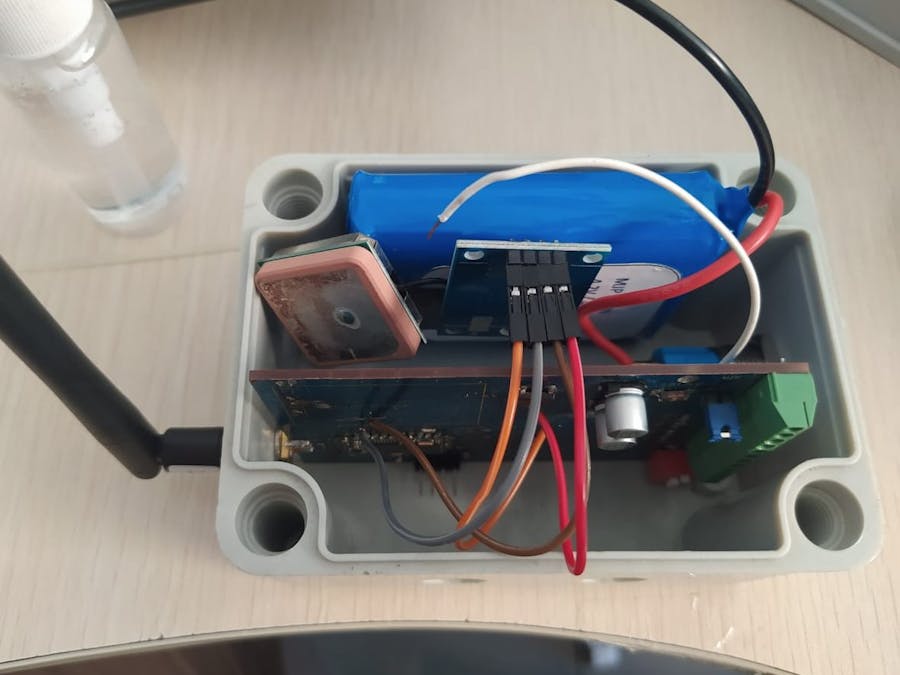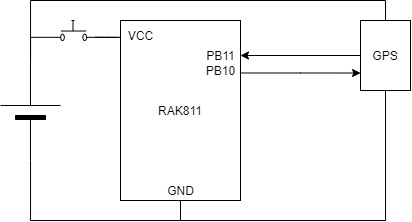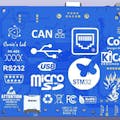During this Covid-19 pandemics, many countries face a crisis in their economics area. Many of them falling into great recession that forces them to create a bond in order to stimulate the economics sector. The side effect of this recession is huge amount of layoffs. Due to sudden unemployment, many of them are not ready and take a shortcut to be a thief.
This project will solve a problem in this particular case by finding the lost vehicle using lorawan and GPS. The GPS will report the location of vehicle and lorawan node (RAK 811) will transmit it to our platform.
RequirementThis project require 1 lorawan sensor-node (RAK 811), 1 GPS board (Ublox Neo 6M), and 1 battery. Then it need to be soldered in several location. Every components then need to put into an enclosure. Here are some pictures of my work.
Fig 1. is lorawan sensornode that integrated with RAK 811, and some voltage converter. The RAK 811 in the fig 1 has lost its shield due to soldering activity. This board is looked awful, actually it is a broken sensornode board from my office that has been thrown into garbage, so literally I am using a trash to compete in this contest, LOL :)). But no worries, after component checking, this board is working fine especially for the RAK811 Board module.The board is combined with GPS Ublox Neo 6M by soldering some jumper cable. The pins that we need to connect is UART TX RX and VCC GND. Fig. 2 show combined device in the enclosure. And fig. 3 is firmware download using cheap ST-Link clone, and to show a result/debug using USB to Serial. Fig 4 is testing part, device is attached to the vehicle.
Important notes:
Before rebuilding this device, there are informations that need to be concerned.
1. This project is implemented in Indonesian Lorawan network. Lorawan network here is working at 921 - 923 Mhz frequency (AS923-2), which is not a standard Lorawan frequency. where we know that standard for lorawan asian network is at 923 - 928 Mhz. The device that using 923 - 928 Mhz fr is actually breaking Indonesian frequency rule that comes from ministry of communications and information. Due to this rule, the national telecom company issuing a standard frequency for Indonesia. The legalize from lora alliance may comes in few months.
Due to this fact, I cant use a standard AS923 in this project. So the frequency need to be updated to Indonesian standard lorawan frequency.
2. In this project, I do not use my own lorawan gateway, the fact is, I dont have any of it (lorawan gateway), and never comes to my mind to buy something expensive that off of my budget :)). So, how did I connect my node to the platform?. The answer is by using a free lorawan gateway that provided by Indonesian national telecom company. This is a pilot project, and it is new in Indonesia, so the gateway is not deployed in every corner of city, only particular area that has the gateway. Gladly, they put some lorawan gateway in my location :)). In US, they have deployed massive of lorawan gateway, that is why many platform like HELIUM are exist.
3. This project using Platform that developed by Indonesian Telecom Company that called ANTARES, so every data that sent from lorawan node, will be received by their gateway, and are shown in their platform. Since it needs much development, It cant be connected easily to the other platform like HELIUM, so I still figure the way out.
FIRMWAREThe main activity of device is described in flowchart below:
The device was set with 2 minute timer to send its data. The data is current location of the device, consist of Latitude and Longitude that acquired from GPS. After we get the data, then it is the duty of lorawan node to send acquired data to platform. Simple scheme :)).
Unfortunately, the maximum length of payload that the platform can receive is 12 characters, so we cant send the lat+long at the same time. By this way, we only can measure our position every 4 minutes.
RESULTThe result of this project is shown in this picture:
The result of position measurement in platform then converted to Google Maps location is shown in pic. 3. Unfortunately, I got only two perfect position data (lat-long). The result of measurement is depend on data that received by gateway from sensornode. And the quality of transmitted measurement data is depend on how far the distance between node and gateway. That is why, the amount of available gateway sometimes decide the quality of data.
CONCLUSION:This device succesfully send the vehicle position from GPS to Lorawan platform. Though this projects goals accomplished, this device is not good enough to perform a robust device tracker due to data lost. This problem can be solved by increasing the amount of gateway in the city.
The alternative for this vehicle tracker is using NB-IoT. I believe NB-IoT will solve that kind of distance problem since they use our GSM network.











_M6kErcYJ84.png?auto=compress%2Cformat&w=40&h=40&fit=fillmax&bg=fff&dpr=2)

Comments
Please log in or sign up to comment.